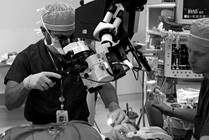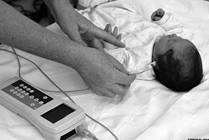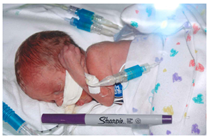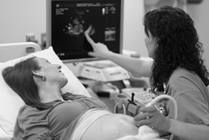Search Results
Viewing: 1-72 of 72 | All

Blog
What To Expect From Ear Tube Surgery
Placing tubes in the ears has many benefits. An ear tube drains the fluid and equalizes the pressure in the middle ear. Ear tubes provide access to the infected area of the ear, allowing the use of eardrops to treat the ear infection.

Blog
Ear Tube Removal: Is it Necessary?
One of the most common surgical procedures in children is the placement of tubes within the eardrum, also known as tympanostomy tubes. Common reasons for initial tube placement include recurrent, acute ear infections or persistent middle-ear fluid which fails to clear over time.

Condition
Otorrhea
Otorrhea is the medical term for ear drainage. In order for there to be drainage from the middle ear into the ear canal, there must be a connection present.

Condition
Tympanic Membrane Perforation
Tympanic membrane perforation can be suspected with a history of ear trauma, ear tubes, frequent ear drainage or hearing loss.
Article
Prescribing Guidelines for Acute Otitis Externa and Otitis Media with Tympanostomy Tube Otorrhea
Due to recent drug shortages and cost increases of the otic solution, Partners For Kids and Nationwide Children’s Hospital’s Otolaryngology Department recommend using Ofloxacin 0.3% ophthalmic solution as an ear drop for a safe and effective alternative.
Ear Infections (Otitis Media)
Ear infections, also known as otitis media, occur when the middle ear is infected or inflamed. There are two main types of otitis media: acute otitis media with effusion (fluid in the middle ear space) and chronic otitis media with effusion.
Article
Community Provider Corner
- In-office Ear Tube Placement
- Measles: Provider Resources
- Wellstone Center Muscular Dystrophy Conference
- Diabetes Management Education
- Heart Center Family Conference

Ear, Nose and Throat Video Resources
Learn more about what to expect during common procedures like ear tube surgery, meet members of the ENT team and hear from families who have received care from Nationwide Children’s.

Ear, Nose & Throat Blog Library
The 700 Children’s blog covers the most common topics, frequently asked questions and current pediatric health care information written by pediatric experts. Our ENT specialists cover the latest from ear infections to noisy snoring to surgeries.
Article
Ear Surgery: Care after Tympanoplasty and/or Mastoidectomy
Your child has had an ear operation, either a tympanoplasty or a mastoidectomy. There are a few things you should do for your child at home.

Condition
Hoarse Voice (Dysphonia)
Dysphonia, also known as hoarseness, refers to having an abnormal voice. For those affected by dysphonia, the voice can be described as hoarse, rough, raspy, strained, weak, breathy or gravely. There may also be voice breaks and pitch changes. Causes may include inflammation, growths and scarring.
Article
MRSA Decolonization
The removal of MRSA is called “decolonization.” Decolonization may help reduce the risk of spreading the germs to others and help to avoid future infections.

Specialty
Ear, Nose and Throat (ENT)
2222 Cherry Street
Suite M800
Toledo, OH, 43608
(419) 251-1020
Click to learn more.
News
Vaccine Being Developed to Prevent Ear Infections in Children
Hoping to prevent ear infections for the more than 15 million children in the United States who suffer from them, a promising new vaccine candidate to prevent middle ear infections (otitis media) is being developed by researchers at the Columbus Children’s Research Institute (CCRI) on the
News
Study Suggests New Way to Prevent Recurrent Ear Infections
Eliminating bacteria’s DNA and boosting antimicrobial proteins that already exist may help prevent middle ear infections from reoccurring. These are the findings from a Nationwide Children’s Hospital study that examined how an immune defense protein common in the middle ear interacts

Blog
Can Antibiotics Help Your Child’s Ear Pain?
It is late at night and your child wakes up with a horrible scream. She is holding her ear, crying and is unable to be consoled. You’ve given her ibuprofen. You’ve given her acetaminophen. These over-the-counter medications help a little, but she is still sobbing, asking you to do something to make it better.
Article
Cleft Lip and Palate Evaluation
Cleft lip and palate may occur as part of an underlying syndrome or be an isolated birth defect.

Blog
How Adenoid Removal May Help Your Child's Chronic Runny Nose
It’s not unusual to see a kid with a stuffy, runny nose or a child with an ear infection. However, these symptoms can also be due to a blockage of the nose due to an enlarged adenoid, which could require additional care.

Blog
When to Take Your Child to an ENT
Ear, Nose, and Throat (ENT) specialists can play an important role in a child’s care and treat a variety of conditions. Here are guidelines to help parents make decisions about when their child should see an ENT.
Otitis Externa (Swimmer's Ear)
Swimmer’s ear, also called otitis externa, is an infection of the skin in the outer ear canal. It is called “swimmer’s ear” because it often occurs when water stays in the ear canal and it is usually caused by bacteria or fungus found in swimming pools, lakes and rivers.
Article
Branchial Cleft Anomaly Excision
Surgical and nonsurgical options if your child has a branchial anomaly.

Blog
Our Top 10 Blog Posts of 2017
For the past three years we have saved a slot on our calendar to list the top 10 posts of the year. In 2017, we shared year-over-year favorites, trending and newsworthy topics and told you about new initiatives.

Condition
Giant Neck Mass
A giant neck mass is an abnormal growth of the neck. There are two different types of masses including cervical teratomas and lymphatic malformations. The cause of it is unknown, but it can be treated.
Article
Video Laryngeal Stroboscopy
What you need to know about a video laryngeal stroboscopy (VLS) procedure.

Condition
Submucous Cleft Palate
A submucous cleft palate (SMCP) results from a lack of normal fusion of the muscles within the soft palate as the baby is developing in utero. Frequent middle ear infections, nasal speech and early feeding difficulties may be the first indicators that a child has a submucous cleft palate.

Blog
Little Ears and Little Voices: Speech and Hearing Care for Preemies
Learn why early identification and treatment of speech and hearing disorders is critically important for all infants and children.

Blog
Submucosal Cleft Palate: A 'Hidden' Cause of Speech and Middle Ear Problems
A submucosal cleft palate (SMCP) results from a lack of normal fusion of the muscles within the soft palate as the baby is developing in utero. It occurs in about 1 in 1,200 children.
Article
Peripheral Nerve Catheter and Pump for Pain Control (PNC) Inpatient
Prepare for your child's peripheral nerve catheter with this Helping Hand.

Condition
Bronchiolitis
This Helping Hand™ covers bronchiolitis, which is an infection of the small airways (bronchioles) caused by a virus. The most common viruses that cause it are RSV, para influenza virus, rhinovirus (common cold), human metapneumovirus and adenovirus. Bronchiolitis is also often called "RSV infection."
News
Genome Sequence for Haemophilus Influenzae Completed by Researchers at Columbus Children's Hospital
Haemophilus influenzae is a common cause of otitis media (ear infections) in children and is the number one reason young children are seen by pediatricians.

Blog
What Is the Right Way To Stop a Nosebleed?
At some point during childhood, almost every kid will have a nosebleed. Here are some tips about caring for nosebleeds – and when it’s time to get your pediatrician involved.

Condition
Paradoxical Vocal Cord Dysfunction (PVCD)
With Paradoxical Vocal Cord Dysfunction (PVCD), the vocal cords close together, or constrict, when a person inhales, leaving only a small opening for air to flow into the windpipe.
Article
Nasogastric Tubes (Insertion and Feeding)
Feeding tubes are often used for babies and young children who are not able to take in enough calories by mouth. If the tube is placed through the nose into the stomach, it is called a nasogastric tube (NG tube).
June 2025
Read the June 2025 issue of Medstat.

Blog
Malone Appendicostomy: Relief From Chronic Constipation
A Malone appendicostomy is a surgery that makes a pathway from the belly button to the colon. It is used as a treatment for kids with chronic constipation.
Article
Button Battery Safety
More and more household items have button batteries. These items include: remote controls, thermometers, games, toys, hearing aids, calculators, bathroom scales, musical greeting cards, key fobs, electronic jewelry, holiday ornaments, cameras, and candles

Condition
Vocal Fold Nodules
Vocal fold or vocal cord nodules are small, non-cancerous growths on your child’s vocal cords. They are often caused by voice abuse. Over time, your child’s repeated misuse of the vocal folds results in soft, swollen spots on each vocal fold.
Article
Oxygen Therapy at Home
The cells in our bodies need oxygen to live. Without enough oxygen, growth and development can slow down. This Helping Hand includes helpful information if your child is prescribed oxygen therapy at home.
Article
Direct Laryngoscopy and Bronchoscopy
Learn about a direct Laryngoscopy and/or Bronchoscopy procedure to examine a voice box.
Article
IV: PICC Line
The PICC line is a plastic tube that is inserted into a large vein to give intravenous therapy.

Blog
What is Emergence Delirium?
As an anesthesiologist I have answered every question about the risks of anesthesia before procedures. I understand, it can be scary. Including questions like: "my child just had her tonsils out, why is she acting like a child possessed?" "My child just had ear tubes and he woke up and is hitting
Article
Secondhand Smoke
Secondhand smoke is what you breathe in when you are around a smoker. It is what the smoker breathes out and the smoke that comes from the burning end of a cigarette, cigar or pipe. It contains more than 4,000 chemicals. There is no safe level of exposure.

Condition
Persistent Diarrhea & Malabsorption
Diarrhea lasting more than seven days is considered persistent, while less than seven days is acute. Diarrhea that lasts more than 30 days is chronic. Toddler's diarrhea is caused by a diet low in fat and high in sugar and fluids. Malabsorption is the inability to use the food the body takes in.
Article
IV: Implanted Port
The implanted port is a device that is placed under the skin. It lessens the need to start an IV for every treatment.

Condition
Subglottic Stenosis
Subglottic stenosis is a narrowing of the airway in the part of the voice box below the vocal cords (glottis). There are two kinds of subglottic stenosis: congenital subglottic stenosis and acquired subglottic stenosis.

Condition
Noisy Breathing (Stertor, Stridor or Wheezing)
Noisy breathing is common, especially in children. and can be a sign of many different conditions. Noisy breathing is typically caused by a partial blockage or narrowing at some point in the airways. Types of noisy breathing include low-pitched, stridor and wheezing.

Blog
Teaching Kids American Sign Language
There are many valuable benefits to learning ASL; research shows sign language promotes strong literacy and communication skills, and is used by individuals with other communication, learning or developmental disabilities.
Article
Temperature: Digital and Glass Thermometers
Learn how to use all three kinds of thermometers for your child.
Article
Winter Weather Advisory
Winter brings injuries unique to cold weather sports. Two of the more common categories of injuries are those influenced by environmental conditions and accidents.

Condition
Micrognathia
Micrognathia is when the lower jaw is smaller than normal. In some cases, this can cause problems with feeding, breathing and sleeping.

Condition
Lymphatic Malformation
A lymphatic malformation is the result of abnormal formation and development during fetal development of the otherwise normal lymphatic vessels in the body. This is usually in one area of the body: neck, chest, abdomen and extremities.
Condition
Upper Respiratory Infections (Colds)
The common cold is a respiratory infection caused by a virus (germ). Rhinoviruses are the most common cause. Viruses are spread by breathing in air droplets of the infected person who coughs, sneezes or even laughs less than 6 feet from your child. The virus can also be spread by touching something that the infected person has sneezed, coughed or drooled on.

Condition
Intracranial Hypertension (Pseudotumor Cerebri)
Idiopathic intracranial hypertension, sometimes called pseudotumor cerebri, is a condition in which the cerebro-spinal fluid is not able to drain normally.
Article
Fiberoptic Endoscopic Evaluation of Swallowing (FEES)
A fiberoptic endoscopic evaluation of swallowing (FEES) is a test used to see if a child has dysphagia.

Condition
Pierre Robin Sequence
Pierre Robin Sequence is a condition that affects a baby’s mouth. It usually involves a cleft palate and a small lower jaw. This can impact breathing and feeding.
Article
Awards and Recognition
Medical staff leadership would like to acknowledge physicians for recently receiving positive comments from patients and families.
Article
Awards and Recognition
Medical staff leadership would like to acknowledge physicians for recently receiving positive comments from patients and families.

Blog
Frostbite: Symptoms, Treatment and Prevention
Winter has finally arrived! While playing outside in cold weather, it’s important to be mindful of the risk of frostbite.

Blog
Gillian's Journey: One Micro-Preemie's Story of Hope
This story was shared by a Justice associate about her journey with Nationwide Children’s in support of the Give Hope Campaign. Eight years ago, Robyn and her husband, Jason, were delighted with the news of her pregnancy.

Specialty
Intracranial Hypertension Clinic
The recognition of idiopathic intracranial hypertension in children has increased dramatically. We are leading the response to this trend with the development of a multidisciplinary clinic for the specialized diagnosis, treatment and ongoing care of these unique children.

Condition
Meningitis
Meningitis is an infection of the meninges. These are the membranes that cover the brain and spinal cord.
Kawasaki Disease
Kawasaki Disease is the most common cause of acquired heart disease in the United States and Japan. The disease can cause blood vessels to become inflamed or swollen throughout the body. It is more common in boys and in Asians and Asian-Americans.

Specialty
The Fetal Center
The Fetal Center offers advanced diagnostic, treatment and recovery options for families facing complex birth defects. We are devoted to improving neonatal outcomes for most fetal complications while supporting you along the way.

Article
Social Media at Nationwide Children's
We are always listening. Connect with us on social media. We look forward to the conversation!
Article
STINKY University DIY Sessions
Below you will find video clips, gross recipes, and PowerPoint slides that will help YOU become an Instructor of Ickiness! Kids will become Graduates of Grossness! Lesson Plans include supplies needed for hands-on activities.
Article
News and Announcements
Stay up to date with the latest news coming out of the Office of Technology Commercialization.
Article
Student Publications
All of the following publications had a student as either the lead author or as a co-author. Students' names are in bold in the citation.
